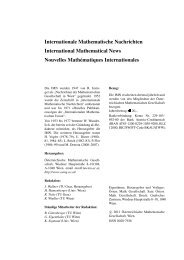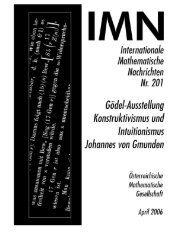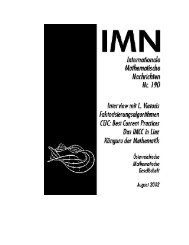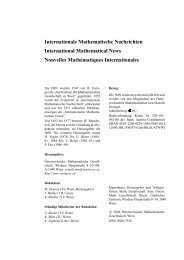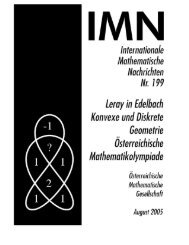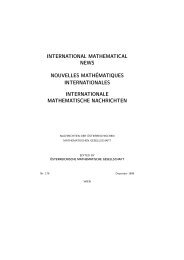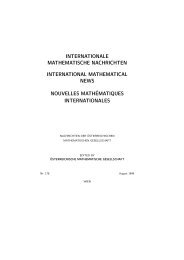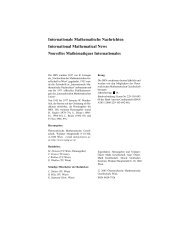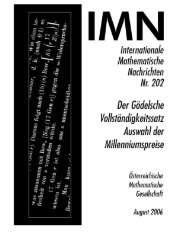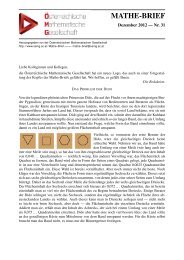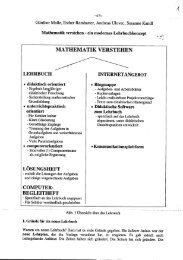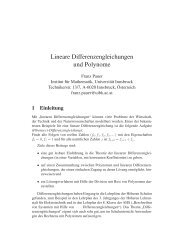Redaktion: K. Sigmund, G. Greschonig (Univ. Wien, Strudlhofgasse ...
Redaktion: K. Sigmund, G. Greschonig (Univ. Wien, Strudlhofgasse ...
Redaktion: K. Sigmund, G. Greschonig (Univ. Wien, Strudlhofgasse ...
Sie wollen auch ein ePaper? Erhöhen Sie die Reichweite Ihrer Titel.
YUMPU macht aus Druck-PDFs automatisch weboptimierte ePaper, die Google liebt.
136 Angewandte Mathematik, Industrie- und Finanzmathematik<br />
On applications of Thom’s isotopy lemma in the theory of<br />
mathematical programming<br />
HARALD GÜNZEL<br />
<strong>Univ</strong>ersity of Alicante, Fac. of Sience, Dept. EIO, 03080 Alicante, Spain<br />
guenzel@ua.es<br />
In mathematical programming a huge variety of objects to study may be defined<br />
as the common solution set of finite systems consisting of both equalities and<br />
inequalities in R n .<br />
Provided the defining functions to be smooth and in general position, the Thom<br />
isotopy lemma states that, locally, the considered solution set has the structure of<br />
a product of a so-called fiber with some Euclidean space. Here the fiber is a stratified<br />
set, i.e. it can be partitioned into differentiable manifolds in a certain, regular,<br />
way. Thus, the entire (local) complexity of the treated set is already contained in<br />
the fiber.<br />
This leeds to various types of applications. A rather direct application of the<br />
lemma yields structural stability results. Here solution sets are compared, defined<br />
by the same system (of equalities and inequalities), however with slightly changed<br />
defining functions.<br />
However, even sets defined by totally different defining systems can be (locally)<br />
compared; as long as one can be sure of the property that the sets of possible fibers<br />
coincide. These ideas, for example, provide a rather short proof of the well known<br />
manifold property of the Karush-Kuhn-Tucker set in parametric optimization.<br />
Analyse von optischen Flussmodellen mit Hilfe der<br />
Variationsrechnung<br />
WALTER HINTERBERGER<br />
(gemeinsam mit Otmar Scherzer, Christoph Schnörr, Joachim Weickert)<br />
Altenbergerstr. 74, 4040 Linz<br />
Walter@mathconsult.co.at<br />
Zur numerischen Simulation des optisches Flußes, zur quantitativen Analyse<br />
von Veränderungen in Bildsequenzen, werden parameterabhängige Optimierungsfunktionale<br />
minimiert. Alle derzeit in der Literatur dargestellten Optimierungsfunktionale<br />
bestehen aus einem Vergleichsterm mit den Daten der Bildsequenz<br />
und einem Stabilisierungssterm.<br />
Wir studieren Existenz von minimierenden Elementen dieser Optimierungsfunktionale.<br />
Diese Fragestellung kann für viele optische Flußmodelle mit Hilfe von<br />
klassischer Variationsrechnung (Morrey, Dacorogna) in Sobolev-Räumen beantwortet<br />
werden. Wir präsentieren kürzlich entwickelte Modelle die auf Optimierungsprobleme<br />
in den Räumen von Funktionen von beschränkter Variation und



